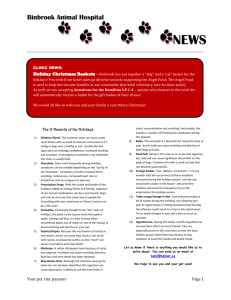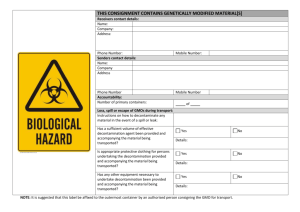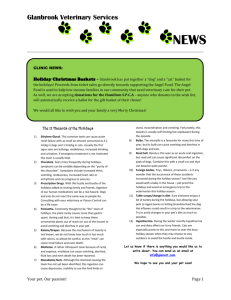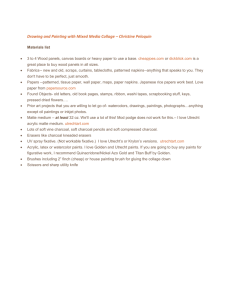Common Toxicities * Speaker*s Notes
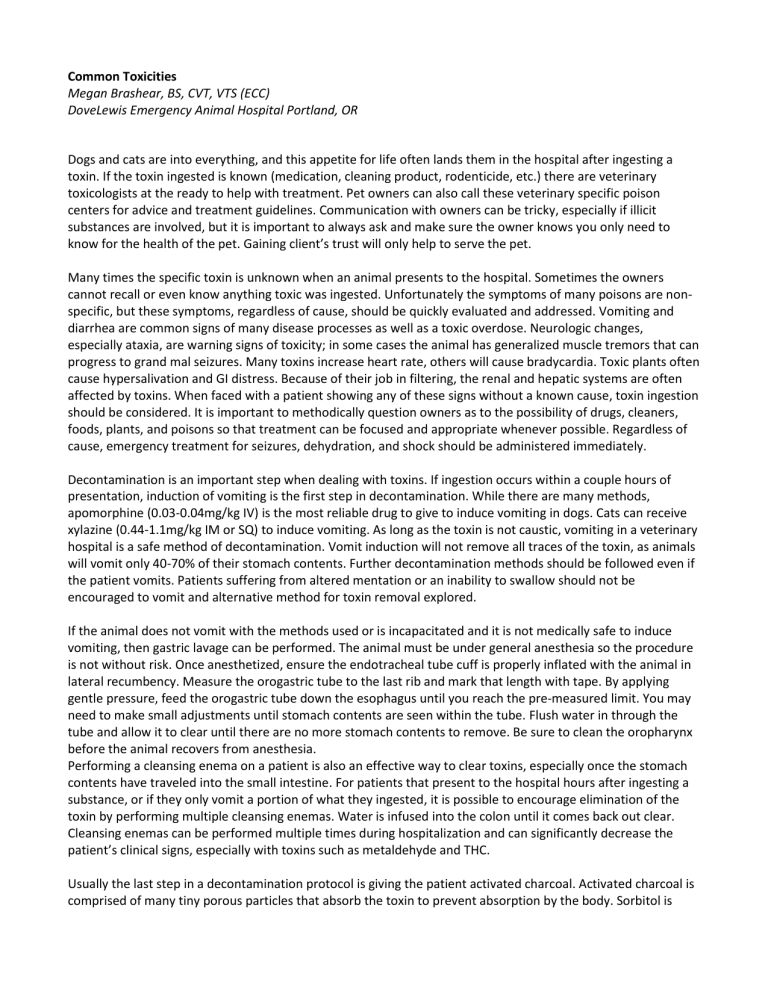
Common Toxicities
Megan Brashear, BS, CVT, VTS (ECC)
DoveLewis Emergency Animal Hospital Portland, OR
Dogs and cats are into everything, and this appetite for life often lands them in the hospital after ingesting a toxin. If the toxin ingested is known (medication, cleaning product, rodenticide, etc.) there are veterinary toxicologists at the ready to help with treatment. Pet owners can also call these veterinary specific poison centers for advice and treatment guidelines. Communication with owners can be tricky, especially if illicit substances are involved, but it is important to always ask and make sure the owner knows you only need to know for the health of the pet. Gaining client’s trust will only help to serve the pet.
Many times the specific toxin is unknown when an animal presents to the hospital. Sometimes the owners cannot recall or even know anything toxic was ingested. Unfortunately the symptoms of many poisons are nonspecific, but these symptoms, regardless of cause, should be quickly evaluated and addressed. Vomiting and diarrhea are common signs of many disease processes as well as a toxic overdose. Neurologic changes, especially ataxia, are warning signs of toxicity; in some cases the animal has generalized muscle tremors that can progress to grand mal seizures. Many toxins increase heart rate, others will cause bradycardia. Toxic plants often cause hypersalivation and GI distress. Because of their job in filtering, the renal and hepatic systems are often affected by toxins. When faced with a patient showing any of these signs without a known cause, toxin ingestion should be considered. It is important to methodically question owners as to the possibility of drugs, cleaners, foods, plants, and poisons so that treatment can be focused and appropriate whenever possible. Regardless of cause, emergency treatment for seizures, dehydration, and shock should be administered immediately.
Decontamination is an important step when dealing with toxins. If ingestion occurs within a couple hours of presentation, induction of vomiting is the first step in decontamination. While there are many methods, apomorphine (0.03-0.04mg/kg IV) is the most reliable drug to give to induce vomiting in dogs. Cats can receive xylazine (0.44-1.1mg/kg IM or SQ) to induce vomiting. As long as the toxin is not caustic, vomiting in a veterinary hospital is a safe method of decontamination. Vomit induction will not remove all traces of the toxin, as animals will vomit only 40-70% of their stomach contents. Further decontamination methods should be followed even if the patient vomits. Patients suffering from altered mentation or an inability to swallow should not be encouraged to vomit and alternative method for toxin removal explored.
If the animal does not vomit with the methods used or is incapacitated and it is not medically safe to induce vomiting, then gastric lavage can be performed. The animal must be under general anesthesia so the procedure is not without risk. Once anesthetized, ensure the endotracheal tube cuff is properly inflated with the animal in lateral recumbency. Measure the orogastric tube to the last rib and mark that length with tape. By applying gentle pressure, feed the orogastric tube down the esophagus until you reach the pre-measured limit. You may need to make small adjustments until stomach contents are seen within the tube. Flush water in through the tube and allow it to clear until there are no more stomach contents to remove. Be sure to clean the oropharynx before the animal recovers from anesthesia.
Performing a cleansing enema on a patient is also an effective way to clear toxins, especially once the stomach contents have traveled into the small intestine. For patients that present to the hospital hours after ingesting a substance, or if they only vomit a portion of what they ingested, it is possible to encourage elimination of the toxin by performing multiple cleansing enemas. Water is infused into the colon until it comes back out clear.
Cleansing enemas can be performed multiple times during hospitalization and can significantly decrease the patient’s clinical signs, especially with toxins such as metaldehyde and THC.
Usually the last step in a decontamination protocol is giving the patient activated charcoal. Activated charcoal is comprised of many tiny porous particles that absorb the toxin to prevent absorption by the body. Sorbitol is
used as an activated charcoal additive and is a cathartic to encourage faster passage of the toxin through the body. Activated charcoal is most effective the sooner it is administered post ingestion, but for toxins that undergo enterohepatic recirculation it is administered every 4-8 hours for up to 3 days. Not every toxin will bind to charcoal, those with –ol (xylitol, alcohol for example) do not bind, therefore administration is not helpful.
The use of intravenous lipid emulsion is an emerging treatment for certain toxicities. Local anesthetics, ivermectin, pyrethrins, metaldehyde, marijuana, and fat soluble medication toxicities can be treated with intravenous lipids. Most IV lipids are formulated so they can be administered through a peripheral line requiring some extra attention by the nursing staff. IV lipids can be used in conjunction with other treatments (vomit induction, charcoal, etc) and reported side effects are uncommon. Lipids can be difficult to obtain as they come on and off backorder so many advocate saving them for the most critical of patients. General protocols state that with a 20% lipid emulsion, give 1.5ml/kg over 1-15 minutes then continue as a CRI at 0.25ml/kg for 30min-2 hours.
Common Toxicities of Dogs and Cats:
Chocolate: Clinical signs are caused by theobromide and caffeine and include vomiting and diarrhea, tachycardia, muscle tremors, seizures, coma and death. Decontamination and giving activated charcoal are first steps, and IV fluid administration if clinical signs warrant. Medications like propranolol to decrease heart rate may be necessary.
Milk Chocolate: wt (#) x 0.3 = oz needed for reaction
Dark Chocolate: wt (#) x 0.12 = oz needed for reaction
Baking Chocolate: wt (#) x 0.04 = oz needed for reaction
Marijuana: Clinical signs are caused by THC and include ataxia, depression, leaking urine, and bradycardia. In some cases extreme excitability and hyperthermia have been noted. Decontamination, activated charcoal and supportive care should be provided until resolution of clinical signs.
High safety margin, treat symptomatically
Zinc: toxicity comes from medication containing zinc or from stomach acid eroding pennies minted after 1982.
Zinc attacks rapidly dividing cells and first causes vomiting diarrhea and eventually hemolytic anemia and renal/ hepatic failure. Surgical removal of the pennies is necessary followed by treatment for the anemia. Chelating
(with calcium EDTA) may also be necessary.
Xylitol: Is a sugar substitute showing up in many products (gum and toothpaste are the most popular). Cats are not as highly affected as dogs. In low doses xylitol causes an insulin release in dogs leading to hypoglycemia.
Higher doses can cause acute hepatic failure and death. Vomiting may or may not be effective in these dogs because it is absorbed rather quickly. Activated charcoal is not helpful in these cases. A dog that has ingested
>0.1mg/kg should be evaluated and monitored for hypoglycemia, hypokalemia, and hypophosphatemia.
NSAIDs: Clinical signs are not always caused by an overdose; in some patients the prescribed dose can cause illness. At the low end of toxicity, clinical signs are GI (vomiting, diarrhea) in nature, sometimes leading to GI ulceration and bleeding. At higher toxic doses, hepatic and renal changes can occur, sometimes permanent.
Overdoses of both veterinary and human medications need decontamination, charcoal, and at least 48 hours of
IV fluid therapy checking renal and hepatic values before discontinuing IV fluids. At extremely high doses, neurologic signs can be seen, with seizures and CNS depression/coma. All NSAIDs should be used with extreme caution in cats.
Ibuprofen: 50-125mg/kg GI signs; >250mg/kg renal signs
Carprofen: 20mg/kg GI signs; 40-50mg/kg renal signs
Naproxen: long half-life (35-72hrs) may extend treatment. 15mg/kg/day GI signs
Aspirin: 110mg/kg (platelet disorders along with GI signs)
Acetaminophen: Cats have an increased sensitivity to acetaminophen. The metabolism of the drug in both dogs and cats can lead to hepatic failure. GI signs occur first followed by facial edema and cyanosis.
Acetaminophen also causes methemoglobinemia (hemoglobin is damaged and hangs on to oxygen instead of releasing it to tissues) which is characterized by brown mucus membranes and chocolate brown blood. Hypoxia occurs in these patients. Heinz bodies can form on red blood cells causing them to be destroyed, and anemia can also occur. Overdose is treated first with decontamination and charcoal.
N-Acetylcysteine is the antidote (140mg/kg loading dose, 70mg/kg q6h for 7 treatments) and can be administered either IV (filter recommended) or PO. N-Acetlycysteine should be diluted to a 5% solution before patient administration. Treatment is rounded out with vitamin C (thought to reduce methemoglobinemia), GI protectants, oxygen and supportive care. o Cats: 5-10mg/kg toxic dose o Dogs: >50mg/kg toxic dose
Tremorogenic Toxins: Include compost/molds, metaldehyde (slug bait) and pyrethrins (topical flea products).
These toxins cause generalized muscle tremors leading to seizures. Topical meds should be washed off as the first treatment. Decontamination with vomiting or gastric lavage and cleansing enemas is followed by charcoal administration. Treatment is symptomatic and supportive with IV fluids. Muscle relaxants (methocarbamol
50mg/kg IV up to 330mg/kg/day) can assist with decreasing tremors and may be combined with diazepam. In extreme cases, general anesthesia may be required. Most easily maintained with propofol.
Albuterol: dogs chewing on an albuterol inhaler can puncture the container and receive a large dose of albuterol. It is a stimulant and can cause immediate tachycardia and cardiac dysrhythmias. Hypokalemia can also occur and should be monitored. Treatment is aimed at controlling cardiac signs until resolution.
Dogs and sometimes cats also ingest a number of human medications. Owners should call a veterinary poison control center for treatment guidelines when this occurs. ADHD and anti-depressant medication ingestions are relatively common. These will often result in neurologic signs when higher doses are ingested. Certain types of medication can cause serotonin syndrome which can lead to severe neurologic depression, seizures, and death.
Decontamination and charcoal administration should be performed and treatment aimed at controlling symptoms. Cyproheptadine (1.1mg/kg) can be administered to combat CNS stimulation – it can be crushed and given rectally if the patient cannot swallow.
Rodenticides continue to be a popular reason for pets to visit the hospital. Recent changes in manufacturing see companies moving away from anti-coagulant toxins, so asking the owners to bring the packaging will help guide proper treatment.
Anti-coagulant rodenticides can be first or second generation, second generation requiring a longer course of treatment so if possible the packaging should be brought in. PT elevations can be noted days after ingestion as well as spontaneous hemorrhage. Vitamin K (3-5mg/kg/day for 3-6 weeks) is administered as treatment, with a recommended recheck of clotting times 48-72 hours post the end of vitamin K.
Symptomatic treatment in the hospital with RBC and plasma transfusions may be necessary if decontamination does not occur in a timely manner and the animal is hemorrhaging.
Bromethalin is also used in rodenticides and is much more dangerous than anticoagulants as no antidote exists. In high doses, animals will experience tremors, CNS depression, seizures and death. In lower doses ataxia, CNS depression and ascending hindlimb paralysis can occur. Symptomatic therapy for clinical signs should be administered, although prognosis is poor once CNS signs develop. Less severe intoxications can make a full recovery.
Cholecalciferol (vitamin D3) is also used in some rodenticides and it will increase plasma calcium and phosphorus levels leading to PU/PD, GI signs, muscle weakness, and renal failure. These patients need decontamination, charcoal, 0.9%NaCl IV diuresis, often IV furosemide, phosphate binders and prolonged hospitalization until plasma calcium levels are normal.
Dogs that ingest mole/gopher bait (zinc phosphide) need some special precautions taken. When ingested, zinc phosphide combines with stomach acid to form phosphoric gas which can lead to stomach distention and clinical signs associated with GDV. Vomiting can also occur. This gas is harmful to people (respiratory signs) so when these dogs vomit, care must be taken that the area is well ventilated. Decontamination and charcoal should be administered and supportive care provided for these patients until the signs resolve.
Mushrooms: Hallucinogenic mushrooms can cause severe CNS excitement in dogs – decontamination performed and charcoal administration should be the first steps. Cyproheptadine (1.1mg/kg) can be administered PO or rectally to manage CNS excitement and the animal treated symptomatically. There are many wild mushrooms that are hepatotoxic to dogs, if the owner is concerned about mushroom ingestion the dog should be seen right away for decontamination and charcoal administration. Clinical signs include vomiting and diarrhea, sometimes in extreme volumes. Treatment is supportive with IV fluid diuresis making sure to monitor liver values. Liver failure can occur from mushroom ingestion.
Iron: Toxicity can occur from ingesting vitamins, human supplements, and “pet-safe” slug bait. Clinical signs include depression and GI signs. GI ulceration is common and can cause strictures as they heal. Treatment is decontamination (activated charcoal is not helpful) and clinical signs managed (usually GI signs in low levels of toxicity) followed by deferoxamine is needed to chelate the iron.
When dealing with any pet that has ingested a toxin the ABCs should be the first priority. Making sure the animal is breathing well and has reasonable perfusion is important before moving on. If the animal’s neurologic status is altered that becomes the next priority, using diazepam and muscle relaxants to control clinical signs.
Make sure the body temperature is within normal limits (hyperthermia is common with many toxicities) and treat if it is not. If the toxin is known and vomit induction is recommended this is the next step followed by charcoal administration and monitoring of further clinical signs.
Suggested Reading:
Bonagura, John D., and Robert Warren Kirk. Kirk's Current Veterinary Therapy 14. Philadelphia, PA: Elsevier
Saunders, 2008. Print.
Gfeller, Roger W., and Shawn Messonnier. Handbook of Small Animal Toxicology and Poisonings. St. Louis, MO:
Mosby, 2004. Print.
Peterson, Michael E., and Patricia A. Talcott. Small Animal Toxicology. St. Louis, MO: Saunders/Elsevier, 2006.
Print.
Silverstein, Deborah C., and Kate Hopper. Small Animal Critical Care Medicine. St. Louis, MO: Saunders/Elsevier,
2009. Print.
Johnson T. Intravenous lipid emulsion (IVLE) therapy for selected toxicoses. In: Proceedings of the International
Veterinary Emergency and Critical Care Symposium. San Antonio (TX), September 11, 2011.




